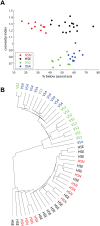The morphological identity of insect dendrites
- PMID: 19112481
- PMCID: PMC2588660
- DOI: 10.1371/journal.pcbi.1000251
The morphological identity of insect dendrites
Abstract
Dendrite morphology, a neuron's anatomical fingerprint, is a neuroscientist's asset in unveiling organizational principles in the brain. However, the genetic program encoding the morphological identity of a single dendrite remains a mystery. In order to obtain a formal understanding of dendritic branching, we studied distributions of morphological parameters in a group of four individually identifiable neurons of the fly visual system. We found that parameters relating to the branching topology were similar throughout all cells. Only parameters relating to the area covered by the dendrite were cell type specific. With these areas, artificial dendrites were grown based on optimization principles minimizing the amount of wiring and maximizing synaptic democracy. Although the same branching rule was used for all cells, this yielded dendritic structures virtually indistinguishable from their real counterparts. From these principles we derived a fully-automated model-based neuron reconstruction procedure validating the artificial branching rule. In conclusion, we suggest that the genetic program implementing neuronal branching could be constant in all cells whereas the one responsible for the dendrite spanning field should be cell specific.
Conflict of interest statement
The authors have declared that no competing interests exist.
Figures




References
-
- Stuart G, Spruston N, Häusser M. Dendrites. Oxford, UK: Oxford University Press; 2008.
-
- Euler T, Denk W. Dendritic processing. Curr Opin Neurobiol. 2001;11:415–422. - PubMed
-
- Koch C, Segev I. The role of single neurons in information processing. Nat Neurosci. 2000;3(Suppl):1171–1177. - PubMed
-
- Yuste R, Tank DW. Dendritic integration in mammalian neurons, a century after Cajal. Neuron. 1996;16:701–716. - PubMed
-
- Miller JP, Jacobs GA. Relationships between neuronal structure and function. J Exp Biol. 1984;112:129–145. - PubMed
Publication types
MeSH terms
LinkOut - more resources
Full Text Sources
Other Literature Sources
Miscellaneous

